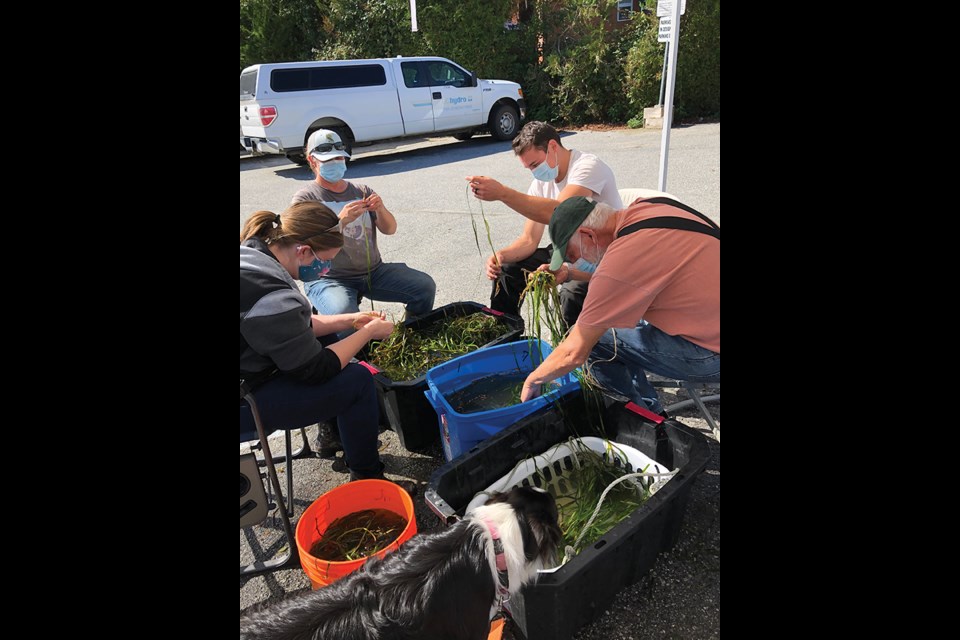Over the course of four years, underwater areas of the Sunshine Coast have been transformed from litter-strewn, debris-ridden sea floor to life-supporting habitat.
Last month, SeaChange Marine Conservation Society’s Salish Sea Nearshore Habitat Recovery Project completed what may be its last eelgrass transplants. Since the project began, it has restored the water-based plant to four regions: Howe Sound, Sechelt Inlet, the southern Gulf Islands and Burrard Inlet. Most recently, volunteers prepared shoots for divers to transplant in Gibsons Harbour, Gambier Island and Sechelt Inlet.
Eelgrass acts as a foundation species by supporting biodiversity, providing habitat and food to around 395 different species in the Salish Sea. Chinook salmon migrating from the Squamish River seek out these “underwater meadows” in West Howe Sound for shelter as they move further out to the Pacific Ocean. Eelgrass also helps to trap sediment and carbon.
Unlike seaweed, eelgrass has a root system, so it requires a shallow area with good sunlight and the right kind of sediment. In the Salish Sea, many areas near the shore are too rocky or steep, but West Howe Sound has the necessary elements required to sustain eelgrass.
On Sept. 8 and 9, more than 25 volunteers helped prepare 2,393 shoots of eelgrass, which were transplanted in Gibsons Harbour and Cotton Bay on Gambier Island. They broke a SeaChange record for how many shoots were prepared in one day, a regional coordinator for SeaChange Marine Conservation Society, Fiona Beaty, said.
But only a few days after the transplant, a sailboat anchored in the Gibsons Harbour transplant site. As of Sept. 28, the boat was still there, Beaty said.
“Its anchor is probably scouring some of the eelgrass that we planted a couple of weeks ago, but we just don’t have the authority to move it. Neither does the harbourmaster or the marina,” she said. Calls to the boat’s owner have gone unanswered.
SeaChange and the Nicholas Sonntag Marine Education Centre had already approached the Town of Gibsons to institute a voluntary no-anchor zone to raise awareness about where the eelgrass is growing and how to avoid negatively impacting the restoration efforts. Similar zones have been established at Bowen
Island and on the American side of the Salish Sea, and efforts are underway to create a zone in Burrard Inlet in collaboration with the Port of Vancouver.
In Gibsons waters, Beaty said they hope to install the buoys in early 2022, and are looking for feedback from the community (which can be sent to [email protected]).
Efforts on Sechelt Inlet received a different response when the team contacted the owner of dock floats positioned over eelgrass beds. The owner “was horrified” by the damage the floats were causing and gave the SeaChange team and divers written permission to move them, after offering to do it themselves, Dianne Sanford, the SeaChange regional coordinator for the inlet, said. The floats only had to be moved several metres.
“Sometimes the smallest things can produce the biggest results,” Sanford said. “It was really a feel-good situation.”
Six tonnes of debris – including an old herring net and a 24-foot sunken sailboat – were removed over four years from otherwise healthy eelgrass habitat in Sechelt Inlet with the help of shíshálh Nation, Transport Canada and community volunteers. On Sept. 21 and 22, volunteers helped prepare 1,338 eelgrass shoots for the second transplant between Porpoise Bay public dock and MacKenzie’s Marina. Staff from the District of Sechelt also joined during their lunch breaks.
“The goal here is to improve the habitat quality, improve the habitat connectivity between the land and sea, because what happens on our beaches and in the foreshore directly affects the health of nearshore species,” Beaty said.
On Sept. 15 and 16, SeaChange returned to Plumper Cove Marine Park on Keats Island, where they had removed 1.75 tonnes of debris from the water there and in Gibsons Harbour last October. Once again, the team removed garbage such as tires, bottles and cans, old engines and kitchen sinks, with in-kind support from the Town of Gibsons and Sechelt Landfill.
“Over the winter and into the spring, it looks like boaters continued to dump their garbage in the water there, which is really frustrating, because you’d think that we’ve moved past that mentality. It seems like we haven’t,” Beaty said.
Now, SeaChange is working with BC Parks to figure out a more proactive approach to prevent waste being dumped at Plumper Cove park, rather than cleaning up after people.
In early 2022, the SeaChange team will return to monitor the growth of the recent eelgrass transplants. Future transplants are not definite, as the program’s funding is expected to end in March next year. But Beaty is hopeful the many community volunteers involved in the transplants will be able to carry the project forward and monitor the progress of the eelgrass.
“The more that you can get people involved, the more likely they’ll be able to practise stewardship and take care of their waterways,” she said.




